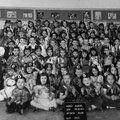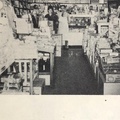“I don’t make it through this side of town too often, these days.”
“When’s the last time you were down here?” I asked.
“Man, it’s been years. I know Tak been tellin’ ya how we went to elementary school together down there at Maryknoll, but we was both from the Westside, and I still live out that way. It’s a straight hike to come down to Li’l Tokyo! Man, it’s kind of a ghost town compared to how I remember it.”
Dean Hirashita bit into his BLT, dipped a french fry in ketchup, and popped it in his mouth.
“I’m glad Tak called me up, though. This is like a homecoming.” He spoke with a laid back, easy drawl.
Dean Hirashita, Tak Tanaka, and I were sitting in the back booth of Mitzie’s Diner on 1st and San Pedro, the only restaurant in Los Angeles’ Little Tokyo of 1998 to get a good hamburger or BLT or, for that matter, a square breakfast of eggs, bacon, and cup of coffee. Dean and Tak had grown up playing Afro-Cuban congas together, and Tak had recently looked him up for a jam session. Both were in their mid-fifties and although they hadn’t seen each other in some time, seemed to pick right up where they’d left off.
Tak was able to book session space in the social hall of Centenary Church, a couple blocks over at 3rd and Central, and had invited me to sit in to check it out. I’d never experienced anything like it, two Japanese Americans playing Afro-Cuban music…and with such soul. I’d suggested, afterward, that we all grab some coffee and unwind. I was curious to hear more of their story.
“We were among the last of the generations to grow up in Li’l Tokyo,” said Tak, taking a bite from his patty melt, “even though we were from the Westside. Dean, you remember that time we took the streetcar in to meet our girls at Nisei Sugar Bowl?”
“Yeeeaah, I remember. They was gooood times, boy.”
“The innocent days, boy,” continued Tak. “We couldn’t have been more than eleven years old. Not like today, we had the run of the city back then. ‘Getting lucky’ for us was holding hands with your girl or sharing two straws in the same milkshake at the drug store counter. Them days is long gone, jack.”
Tak ran a commercial printing business in Los Angeles, and was one of the regular clients of a small graphic design studio where I’d found a job straight out of college in Chicago. I’d chosen L.A. as a place to begin my career not only for its renown as a cutting edge design region, but because of its expansive Japanese American community from which my Nisei (second generation Japanese American) grandparents had been evacuated during World War II.
• • • • •
Along with 110,000 other Japanese Americans post-Pearl Harbor, my grandparents were forcibly incarcerated at one of ten concentration camps constructed by the United States War Relocation Authority to detain West Coast Americans of Japanese ancestry. Having lost their livelihoods in L.A.’s produce market, after camp they resettled in the Midwest where my grandmother found secretarial work in one of Chicago’s many publishing houses and my grandfather apprenticed as a welder in the rich industrial landscape.
The first time I was assigned his account at Hero Designs, Tak Tanaka didn’t just sit me down to tell me what kind of artwork he wanted. Having learned my last name was Shikada, he chopped it up with me for a half hour as though the business of dollars and cents was of no concern.
“You know,” he said, “I was born in Chicago. My parents got work release out of camp while my mother was pregnant, and ended up there. I don’t remember anything about it, because two years later they moved back to L.A. As I understand it, a lot of Sansei have roots in Chicago.”
“Funny,” I replied, “I’m a Yonsei from Chicago with roots in L.A.”
We hit it off immediately, and from that point I jokingly, yet seriously, began calling him “sensei,” a Japanese term of respect for one’s teacher, or mentor. It was a blessing for my first job, my boss elated at the kindredness a good customer had found toward his new hire.
• • • • •
boom BOO TAH BOOM tah BOOM, boom BOO TAH BOOM tah BOOM…
boom DADADAM boom DAH, boom DADADAM boom DAH…
• • • • •
I was sitting with my grandmother at the kitchen table of her Chicago home. Stir-fried vegetables mixed with small slices of meat simmered in a shoyu ginger sauce on the stove. Frank Sinatra played on the radio.
“I think I gravitated toward this music because we lacked affection growing up,” she said. “The Isseis never showed much emotion. But we were together as a people, like Frank Sinatra. He came from an Italian neighborhood in New Jersey like we came from a Japanese neighborhood in California. Sinatra and I are the same age, you know.”
She got up, went to the stove, lifted the lid on the pot, stirred with a wooden spoon, and cut the flame.
Walking back, she said, “I remember hearing a story about Sinatra’s manager wanting him to change his name to sound more American. Something like ‘Frankie Satin.’ They thought ‘Sinatra’ was too Italian. He told them, ‘I like Sinatra. That’s my name.’ I respected him after hearing that.
“You know, I don’t think any kids think of racism growing up, but we also never thought about why we were all stuck together in one district. Everyone we dealt with in Li’l Tokyo was Japanese. I’m sure as a kid Sinatra never thought about why everyone in his neighborhood was Italian. But at some point, he had to make a choice. And he kept his name. I liked that.” She took a sip from her coffee and lit a cigarette. Sinatra sang the blues. “Hey, food’s ready.”
I got up and dished up.
• • • • •
boom BOO TAH BOOM tah BOOM, boom BOO TAH BOOM tah BOOM…
THWAP THWAP THWAP thump thump thump, THWAP THWAP THWAP thump thump thump…
• • • • •
“When we got back to L.A.,” said Tak, taking a bite off his fries, “we holed up at the old Nishi Hongwanji Temple with some other families. That’s where the Japanese American National Museum is now, a block over there at 1st and Central. I don’t remember any of that either, my parents told me about it. I was only two years old then. Eventually my folks were able to find a place over by 36th and Denker, near Senshin Buddhist Temple. To give you an idea of what that area was all about, when I was growing up it was known as ‘Dodge City.’ Centenary Church was there too, over by 35th and Normandie.”
Tak spoke with a similar drawl as Dean, but not as easy-going. His was more staccato, militant even, owing to his background in the Asian American Movement of the ’60s.
“When we were teenagers,” Tak continued, “Centenary used to let us use their facilities for a ‘keep the kids off the streets’ program. Our parents were too busy trying to rebuild their lives and feed us to know what we were up to. But a group of us, we called ourselves ‘The Pastors.’ I guess you could say we took our ethnicity as a religion. In today’s terms you’d call us a gang, and I guess were the gangsters of our day.
“We didn’t take no slack. We were community conscious and as the first post-camp generation of young elders in the ’60s were cognizant of our unique Japanese American history and heritage. To give you an idea, every December 7th at our high school was ‘Beat a Jap Day.’ Well, that nonsense stopped when The Pastors formed. Sixty of us organized one December 7th and challenged the school to ‘Try and Beat a Jap Today.’ They didn’t mess with no buddhaheads that day.
“So, that’s how we got this space to jam at Centenary tonight. Some years ago they moved from the old neighborhood down to Li’l Tokyo, and remembered the work we used to do. We brought kids off the streets to teach them boxing, we played chess, we played music together. We got kids off drugs, and I’ll tell you, we weren’t above street violence as a last course for rehab. Some of these kids we physically scared straight into law school. But hey, that was a different time and we’re old now and just enjoy playing music together.”
“I haven’t seen Tak in yeeeaaars, boy,” Dean piped in. “But man, it’s like no time’s lost. I do kinda feel like Rip Van Winkle, though, the way the neighborhood’s changed.”
• • • • •
boom DADADAM boom DAH, boom DADADAM boom DAH…
poom PA TAP PA TAP poom TAP, poom PA TAP PA TAP poom TAP…
• • • • •
Rebuilt from the ashes of Word War II, Little Tokyo remained the cultural hub for hundreds of thousands of Southern California Japanese Americans, though it was no longer the every day community of either my grandparents’ or Tak and Dean’s generation. Most businesses closed early and the streets, sandwiched by Skid Row and L.A. County Jail, were home to many homeless wanderers.
But a burgeoning arts community had recently begun taking root, attracting youthful energy and after-hours foot traffic. East West Players, an Asian American theatre company, had moved into a multi-purpose arts building renovated from the ruins of an old Japanese church. A bimonthly event called Tuesday Nights at the Café featured local artists and storytellers in the outdoor courtyard of Little Tokyo Café. I had attended an art opening for a local Japanese American painter at a Chinese noodle house across the street from Mitzie’s Diner. Guys like Tak Tanaka and Dean Hirashita flavored the neighborhood air with a melodic sense of the community they grew up in. And Mitzie’s Diner was among the few who stayed open late enough for us to continue our stories into the night.
At a glance, 1998’s Little Tokyo was far from the neighborhood my Nisei grandparents had grown up in. But it was there. For those with a sharp enough spade, it was but a short stab through the veneer of daytime restaurants and tchotchke shops. A ghost town it may have seemed, but a town for ghosts of a community that cared enough to remain to tell the story. It wasn’t the same Little Tokyo I’d heard about two thousand miles and two generations away in my grandma’s kitchen, but it was one I’d be able to tell my grandkids about.
• • • • •
poom PA TAP PA TAP poom TAP, poom PA TAP PA TAP poom TAP…
THWAP THWAP THWAP thump thump thump, THWAP THWAP THWAP thump thump thump…
© 2014 Erik Matsunaga





